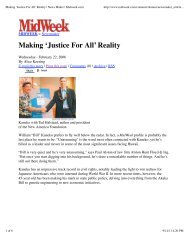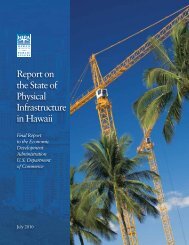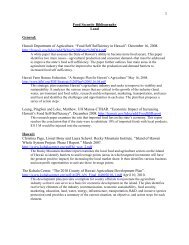Hawai'i Fisheries Initiative - The Hawaii Institute for Public Affairs
Hawai'i Fisheries Initiative - The Hawaii Institute for Public Affairs
Hawai'i Fisheries Initiative - The Hawaii Institute for Public Affairs
Create successful ePaper yourself
Turn your PDF publications into a flip-book with our unique Google optimized e-Paper software.
In its eighth year, 2,164 volunteer<br />
recreational fishers in DAR’s Ulua Tagging<br />
Project have tagged a total of 27,427 ulua<br />
and papio (juvenile ulua), a species highly<br />
targeted by recreational fishers. More than<br />
3,600 recoveries have been made (a 13.3<br />
percent recovery rate), generating important<br />
stock assessment data <strong>for</strong> the species. 195<br />
An opakapaka tag-and-release program is<br />
also ongoing. 196<br />
and the Oceanic <strong>Institute</strong>. 192 In addition,<br />
DAR provides support and infrastructure<br />
assistance to the University of Hawai‘i’s<br />
Sea Grant Extension Program, the Center<br />
<strong>for</strong> Tropical and Subtropical Aquaculture,<br />
Waikiki Aquarium, the Hawai‘i Aquaculture<br />
Association, and the Hawai‘i Cooperative<br />
Fishery Unit, an adjunct of the University<br />
of Hawai‘i Department of Zoology that is<br />
active in graduate training and research in<br />
sport fisheries. 193<br />
DAR works with communities to strengthen<br />
local involvement in the health of their<br />
marine resources through revitalizing local<br />
traditions and natural resource knowledge.<br />
Community-based management of<br />
subsistence fishing areas has been<br />
encouraged by the state since 1994. 194<br />
Consensus building between the different<br />
factions (international, federal, state, local<br />
community, and native peoples) has become<br />
a call-to-action in marine management<br />
circles, not just in Hawai‘i, but throughout<br />
the Pacific and in international <strong>for</strong>ums.<br />
Community-based management signifies<br />
not only incorporating the involvement<br />
of aboriginals, but also including current<br />
residents of coastal communities. Yet,<br />
working examples remain relatively rare<br />
in Hawai‘i. “A few remote areas under<br />
community control have standing stocks<br />
of fishes equivalent to those found in<br />
no-take Marine Life Conservation Districts.<br />
However, despite the fact that no-take marine<br />
refuges and areas under community-based<br />
management have proven to be successful<br />
fisheries management strategies, less than<br />
1 percent of the coastal areas in Hawai‘i<br />
are managed in these ways.” 197 Limitations<br />
on implementation include state funding,<br />
personnel, and en<strong>for</strong>cement issues;<br />
organized community-based management<br />
groups able to go the long haul in<br />
terms of volunteer support and funding;<br />
and navigation by these groups of a<br />
time-consuming regulatory system.<br />
48







